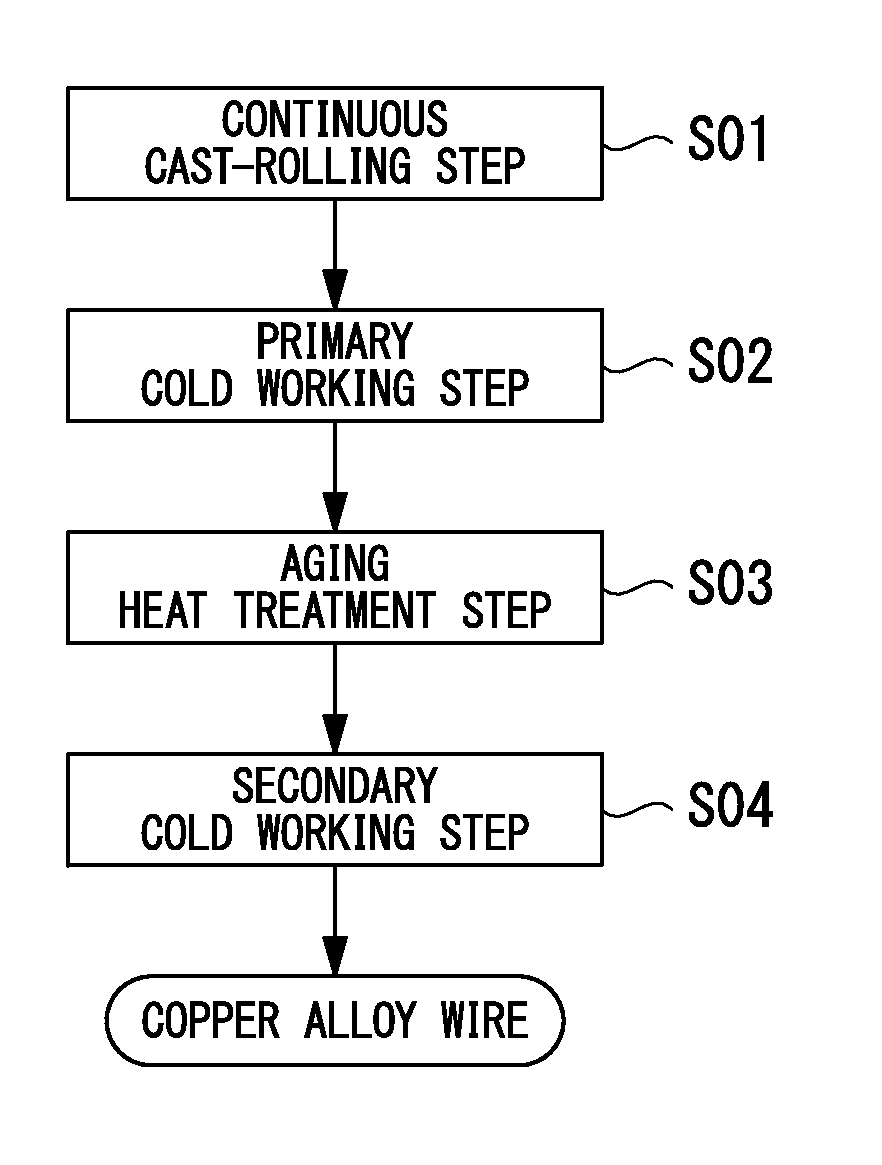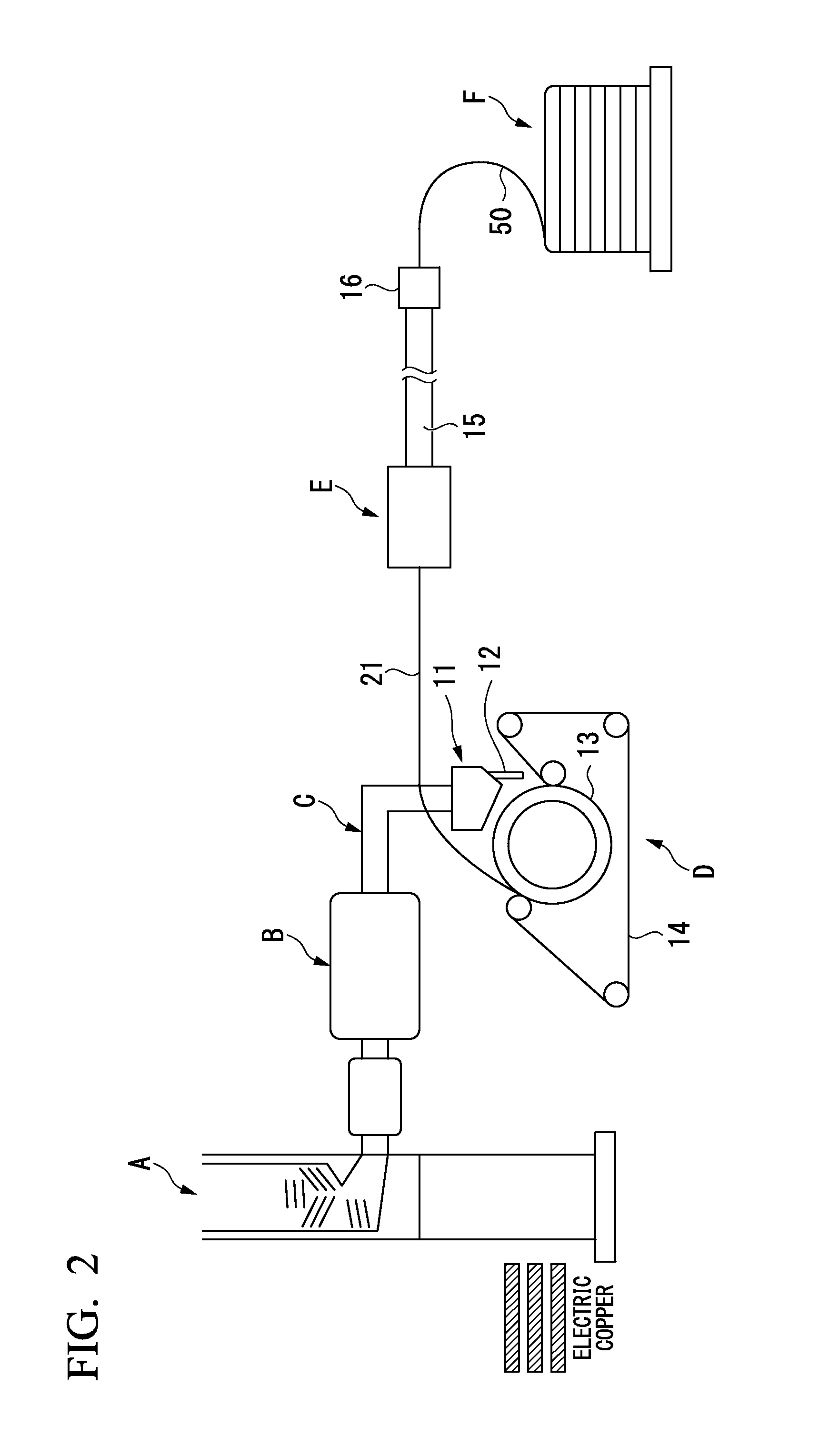Copper alloy wire
- Summary
- Abstract
- Description
- Claims
- Application Information
AI Technical Summary
Benefits of technology
Problems solved by technology
Method used
Image
Examples
example 1
Examples of Present Invention 1 to 13 and Comparative Examples 1 to 5
[0102]Copper wire rods (with an outer diameter of 25 mm) made of a copper alloy having a composition shown in Table 1 were produced using a continuous cast-rolling facility provided with a belt wheel-type continuous caster. Primary cold working was carried out on these copper wire rods so as to reduce the outer diameter to 18 mm, and then an aging heat treatment was carried out under conditions shown in Table 2. After that, secondary cold working was carried out, thereby reducing the outer diameter to 12 mm.
Conventional Example
[0103]A billet having an outer diameter of 240 mm made of a copper alloy having a composition shown in Table 1 was prepared, and was reheated to 950° C., thereby carrying out hot extrusion. Primary cold working was carried out on the obtained extruded material so as to reduce the outer diameter to 18 mm, and then an aging heat treatment was carried out under conditions shown in Table 2. After...
example 2
Examples of Present Invention 21 to 28
[0122]Continuous cast wire rods (with an outer diameter of 25 mm) made of a copper alloy having a composition shown in Table 3 were produced using an upward continuous caster. Primary cold working was carried out on these continuous cast wire rods so as to reduce the outer diameter to 18 mm, and then an aging heat treatment was carried out under conditions of 500° C. and four hours. After that, secondary cold working was carried out, thereby reducing the outer diameter to 12 mm.
Examples of Present Invention 31 to 38
[0123]Continuous cast wire rods (with an outer diameter of 25 mm) made of a copper alloy having a composition shown in Table 3 were produced using a horizontal continuous caster. Primary cold working was carried out on these continuous cast wire rods so as to reduce the outer diameter to 18 mm, and then an aging heat treatment was carried out under conditions of 500° C. and four hours. After that, secondary cold working was carried ou...
example 3
Examples of Present Invention 51 to 64
[0127]Next, as a copper alloy wire for, for example, a use requiring a high balance between the strength and the conductivity such as a wire harness, copper alloy wires in which (Co+P) / Sn was controlled were evaluated as shown in Table 4.
[0128]In Examples of Present Invention 51 to 55, similar to Examples of Present Invention 1 to 13 of Example 1, copper wire rods (with an outer diameter of 25 mm) were produced using a continuous cast-rolling facility provided with a belt wheel-type continuous caster, and primary cold working, a thermal treatment, and secondary cold working were carried out, thereby obtaining copper alloy wires (with an outer diameter of 12 mm) having a composition shown in Table 4.
[0129]In Examples of Present Invention 56 to 58, similar to Examples of Present Invention 21 to 28 of Example 2, continuous cast wire rods (with an outer diameter of 25 mm) made of a copper alloy having a composition shown in Table 4 were produced usi...
PUM
| Property | Measurement | Unit |
|---|---|---|
| Percent by mass | aaaaa | aaaaa |
| Percent by mass | aaaaa | aaaaa |
| Percent by mass | aaaaa | aaaaa |
Abstract
Description
Claims
Application Information
 Login to View More
Login to View More - R&D
- Intellectual Property
- Life Sciences
- Materials
- Tech Scout
- Unparalleled Data Quality
- Higher Quality Content
- 60% Fewer Hallucinations
Browse by: Latest US Patents, China's latest patents, Technical Efficacy Thesaurus, Application Domain, Technology Topic, Popular Technical Reports.
© 2025 PatSnap. All rights reserved.Legal|Privacy policy|Modern Slavery Act Transparency Statement|Sitemap|About US| Contact US: help@patsnap.com



